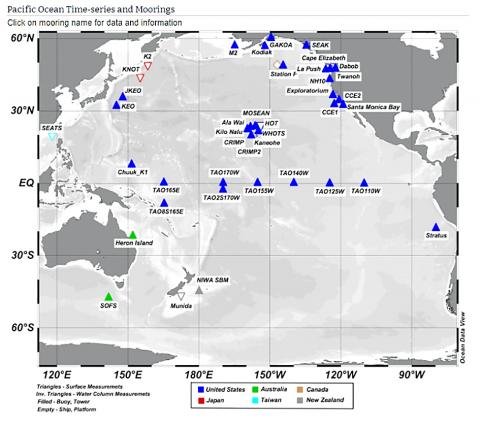The nation’s marine observation station, known as the Southeast Asian Time-Series Station (SEATS), marks its 20th anniversary this year, and is considered one of the key long-term observation stations by the US National Oceanic and Atmospheric Administration’s National Center for Environmental Information, the Ministry of Science and Technology said.
Located in the South China Sea about 670km from Pingtung County’s Kenting (墾丁), the SEATS station was established in 1998 by the then-National Ocean Science Research Center to study carbon circulation as part of the UN’s ocean research program.
The station was established through pooled resources from Academia Sinica, National Taiwan Ocean University, National Taiwan University, National Central University, National Cheng Kung University and National Sun Yat-sen University.

Photo: Screen grab from the US National Oceanic and Atmospheric Administration Web site
“It is an important station to collect data about ocean acidification and global climate change for international academia,” the ministry said, adding that the two subject areas were derived from its original mission to study carbon and biochemistry cycles.
Of the eight long-term marine observation stations in the world, the SEATS station is the only one located in low-latitude waters, National Taiwan Ocean University marine environment and ecology professor Chou Wen-chen (周文臣) said.
Having built his research on data collected at the station, Chou has said ocean time-series research is mainly aimed at exploring the changes of carbon dioxide in oceans and its possible regulation mechanism.
A paper titled “Deducing acidification rates based on short-term time series” authored by Taiwan Ocean Research Institute assistant researcher Lui Hon-kit (雷漢杰) and Chen Chen-tung (陳鎮東), a marine science professor at National Sun Yat-sen University, published in the journal Scientific Reports in 2015, also relied on data collected from the SEATS site.

Costa Rica sent a group of intelligence officials to Taiwan for a short-term training program, the first time the Central American country has done so since the countries ended official diplomatic relations in 2007, a Costa Rican media outlet reported last week. Five officials from the Costa Rican Directorate of Intelligence and Security last month spent 23 days in Taipei undergoing a series of training sessions focused on national security, La Nacion reported on Friday, quoting unnamed sources. The Costa Rican government has not confirmed the report. The Chinese embassy in Costa Rica protested the news, saying in a statement issued the same

Taiwan’s Liu Ming-i, right, who also goes by the name Ray Liu, poses with a Chinese Taipei flag after winning the gold medal in the men’s physique 170cm competition at the International Fitness and Bodybuilding Federation Asian Championship in Ajman, United Arab Emirates, yesterday.

A year-long renovation of Taipei’s Bangka Park (艋舺公園) began yesterday, as city workers fenced off the site and cleared out belongings left by homeless residents who had been living there. Despite protests from displaced residents, a city official defended the government’s relocation efforts, saying transitional housing has been offered. The renovation of the park in Taipei’s Wanhua District (萬華), near Longshan Temple (龍山寺), began at 9am yesterday, as about 20 homeless people packed their belongings and left after being asked to move by city personnel. Among them was a 90-year-old woman surnamed Wang (王), who last week said that she had no plans

TO BE APPEALED: The environment ministry said coal reduction goals had to be reached within two months, which was against the principle of legitimate expectation The Taipei High Administrative Court on Thursday ruled in favor of the Taichung Environmental Protection Bureau in its administrative litigation against the Ministry of Environment for the rescission of a NT$18 million fine (US$609,570) imposed by the bureau on the Taichung Power Plant in 2019 for alleged excess coal power generation. The bureau in November 2019 revised what it said was a “slip of the pen” in the text of the operating permit granted to the plant — which is run by Taiwan Power Co (Taipower) — in October 2017. The permit originally read: “reduce coal use by 40 percent from Jan.